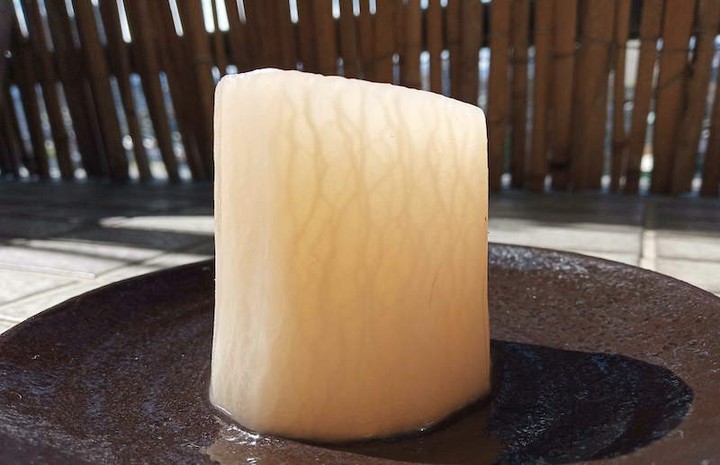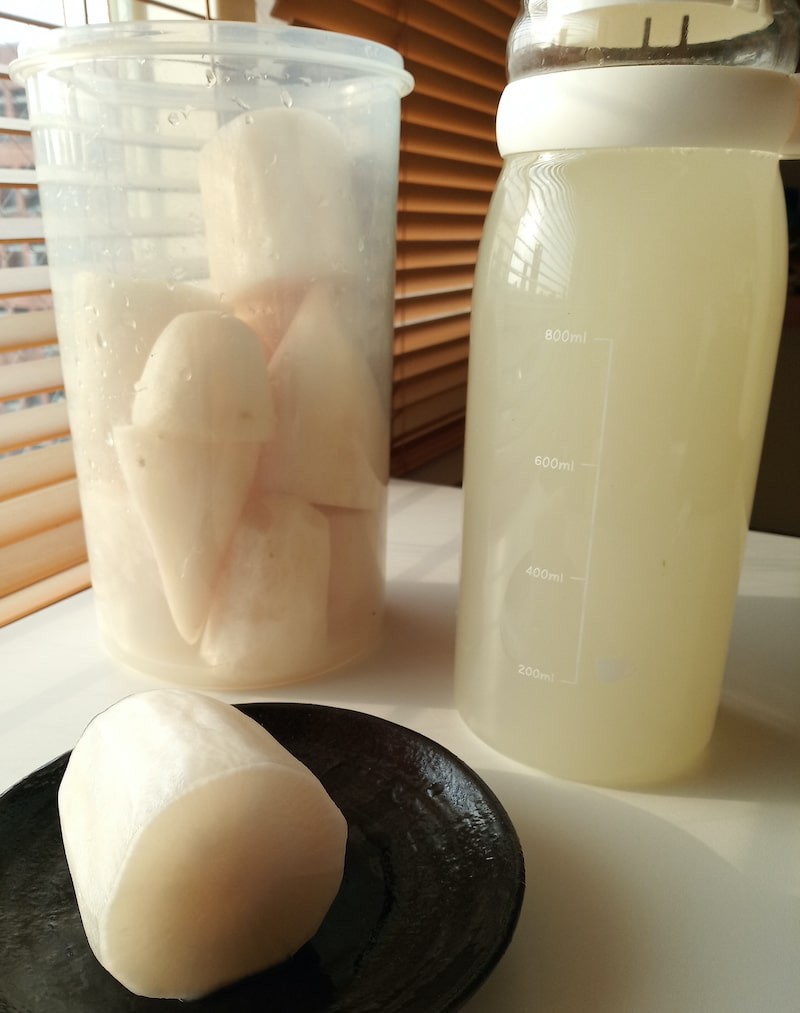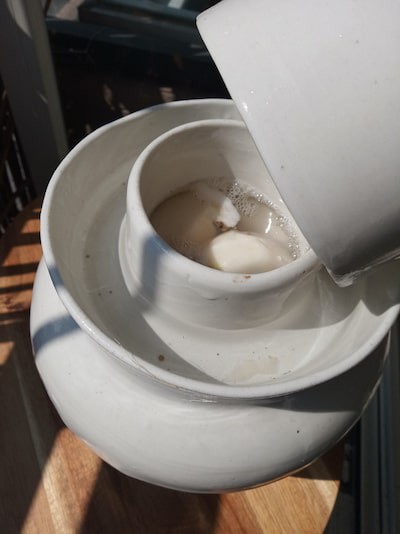How to make lacto-fermented daikon radish? A one-ingredient fermentation recipe

Lacto-fermentation is an ancient method of food preservation that doesn’t need cooking or sterilizing.
By storing food in a container with about 2.5% salt and no oxygen, lactic acid bacteria spontaneously start to develop. This bacterial activity increases acidity up to pH 2-3. At this point, the lacto-fermented mixture is too acidic for further microbial activity and can be kept for months or years.
I think that a great way to venture into lacto-fermentation as a beginner is to make single-ingredient fermentations, as opposed to fermenting mixtures of vegetables and herbs. By fermenting only one vegetable at a time, we simplify the process, but we also get to know better this vegetable and how it behaves during fermentation.
Which new aromas will it develop? How will become its texture? Do you think its color might change during fermentation?
Lactic acid bacteria are very creative. From any vegetable, they multiply, and they manufacture unexpected new flavors. Even with a single ingredient, they come up with very complex and pleasing tastes. I like to think of this new aroma as being the spirit of the vegetable, that expresses itself through fermentation!
For instance, here, I propose to ferment a daikon radish on its own.
In Japan, this big white radish is grated to make a raw pungent dip, sometimes accompanying sushi.
In Taiwan, it is mainly eaten boiled, losing its spiciness and becoming melty in the mouth.
But what about fermenting daikon radish?
What are the special fragrances that lactic acid bacteria develop when breaking down daikon radish?
Let’s uncover this!
Table of content
Ingredients to make lactofermented daikon radish
- Organic daikon radish — enough to fill your container with radish chunks
- Mineral water, or filtered and boiled tap water — enough to cover the radishes
- Salt — from 2 to 2.5 % of the total weight of radish and water
The quality of each of these ingredients will alter the resulting flavors.
Of course, the quality of the radish is important. Apart from your health and the planet’s health, organic daikon radish will also make the development of bacteria easier. Treatments made in industrial farming are designed to kill living beings, while here, on the contrary, we want to warmly nurture living beings.
If you don’t have access to daikon radishes, or if you want another option, I would be very interested in trying for instance those pink, blue, or purple big radishes that seem to have become trendy in French organic shops.
Water will be the matrix where the fermentation takes place. It is hence important that it is of good quality, without pollutants. Boiling is not really necessary for safety, because the absence of oxygen and the high amount of salt will inhibit any microorganism except lactic acid bacteria. However, every little change in the recipe can alter the final taste. So, in order to obtain reproducible results, it can make sense to boil water.
Salt is also important, as it can bring minerals to support the development of bacteria. Fermentation experts can discuss hours to decide which salt works better for this or that fermentation. Whether this sea salt or that rock salt. They look for good-quality salts. But when you make big batches of lacto-fermented food, you may find those salts too expensive, so it is you to find the balance.
Tools
- Knife
- Peeler
- Chop board
- Fermentation container
- Weighing balance

The fermentation container is the most critical tool to make easy and successful lacto-fermentations. The ones I like the most are glass or ceramic fermentation crocks like the one in the picture. They are safe for food and very beautiful on a shelf in the house.
If you don’t have access to such a fermentation crock, I propose other kinds of containers in another article.
Instructions
Executive summary for busy ministers and CEOs:
Put radish, water, and 2.5% salt in a fermentation crock. Close the lid. Wait for several weeks or a few months. Open the lid. Enjoy.
A bit more detailed instructions:
Rinse the radishes. I just rinse the radishes with water. I never use soap, nor do I blanch the vegetables. Actually, I even make sure there is still a little bit of soil on my organic vegetables, to enhance microorganisms’ diversity! These few grams of soil contain millions of bacteria from a variety of species, leading to a more nutritious fermentation and a more complex taste. This is safe because the soil is organic, and because the most important is the growth conditions that select the lactic acid bacteria. Blanching can help to obtain reproducible results, but it is not necessary. Fermenting is really a kind of farming, we farm microorganisms. So we don’t want to kill them first!
Peel the radishes. It is probably not necessary, but as their skin is a bit thick, peeling may quicken a bit the fermentation and ease the preparation for eating later. In this example, I kept the peel on the bottom of the crock, in order to enrich the taste and maybe keep some nutrients that could leach from the peel to the mixture. I actually ended up eating them as well, as they looked like tasty veggie noodles!
Cut the radishes. Here I kept big chunks. A Korean friend told me that in the Korean Peninsula, we can often ferment daikon radishes as a whole, in very big fermentation crocks! If you have a small container, it can be better to cut the radish into smaller pieces.
- Fill the container with radish chunks, water, and salt. Put the radish chunks in the container and pour water to cover the radishes. Then, remove everything to weigh the total amount of water + radishes that fits into the crock. For instance, if ‘radish chunks + water’ = 1 kg, then 2.5 % corresponds to 25 g of salt.
- Close the container and wait. I waited one month for this experiment, at 20-25°C (68-77°F). You can wait for a few days if you prefer low acidity and mild taste, or as long as several months if you look for a tangy and complex aroma. Small chunks will ferment faster than bigger ones.
From that moment, the temperature is the most important parameter. A low temperature slows down the fermentation, a higher temperature speeds it up. A slower fermentation tends to create complex flavors, a faster fermentation increases the risk of developing unwanted yeasts.
You can also smell and taste every day, to monitor and learn how your lactic acid bacteria are working.
How to store fermented daikon radish?
You can eat a chunk every day while letting the other chunks keep fermenting.
But each time you open the lid, oxygen enters. At the beginning of the fermentation, this may favor the development of yeasts, a white layer floating on the top. Those yeast are not harmful, but they clearly alter the final taste, making it less pleasant. Later, while the mixture becomes quite tangy, this acidity stabilizes the population of microorganisms. Letting oxygen enter from time to time does not alter anymore the fermentation significantly.
If you realize at some point that you enjoy the taste and you would like to stop the fermentation process, then, you can just put the fermentation crock or the chunks in the fridge. There, they can stay for weeks or even months. The taste will still evolve, but very slowly, very much like when keeping a bottle of wine for a long time.

How to eat fermented daikon radish?
We can eat raw fermented radish cut in small chunks, as pickles, starters. It is quite salty and acidic, so it can be mixed with other non-salty and non-acidic food on the table to balance it out. In a salad, I use it to add the salty and tangy notes that a salad dressing usually brings.
We can boil fermented radish in a soup or stir-fry it with vegetables. In this case, we lose the enzymes and “probiotics” developed during fermentation, but we add complexity to the taste of the soup or the stir-fried dish. The taste of the fermented radish significantly changes while cooking compared to raw fermented radish.
We can keep the whey — the salty and acidic liquid in the fermentation crock — to make the next lacto-fermentation batch. This increases the fermentation speed and adds a taste of fermented radish to your next experiment. It can also be used as a soup base or a veggie stock for stews.
How does fermented daikon radish taste?
While fermenting, the daikon radish turns translucent! It stays crunchy but less than raw daikon radish. It is definitely salty and acidic. The complex aroma that develops reminds me of some kind of surprising meaty flavor.

To make it less salty, we can reduce the amount of salt in the recipe. To up to 2% of salt, fermentation is likely to work well, especially if you use a container that efficiently prevents oxygen to enter. Below 2% of salt, the risk of yeast developing on the surface increases, but you can still try!
To limit acidity, you have to stop the fermentation by storing the partially fermented radishes in the fridge. At the same time, the aroma will be less complex.
To increase the depth and complexity of the flavor, you can try to ferment the radish for a longer time like 3 to 6 months, at a low temperature like around 15°C (59°F).
Did you enjoy this post?
Great! Then, you may also like to have a look at different kinds of containers we can use to ferment food. Or, you may be interested in discovering my experiments and research about tempeh: okara tempeh, chickpea tempeh, and acorn tempeh.


